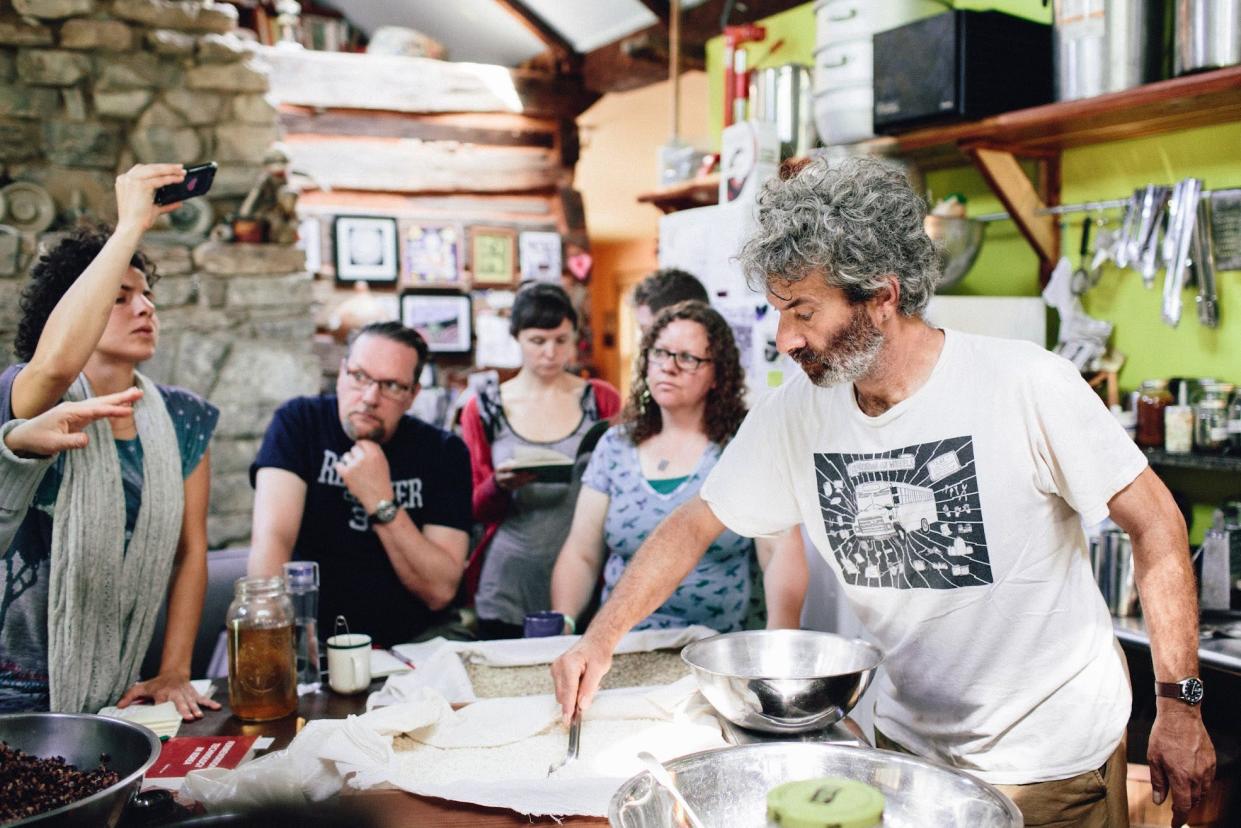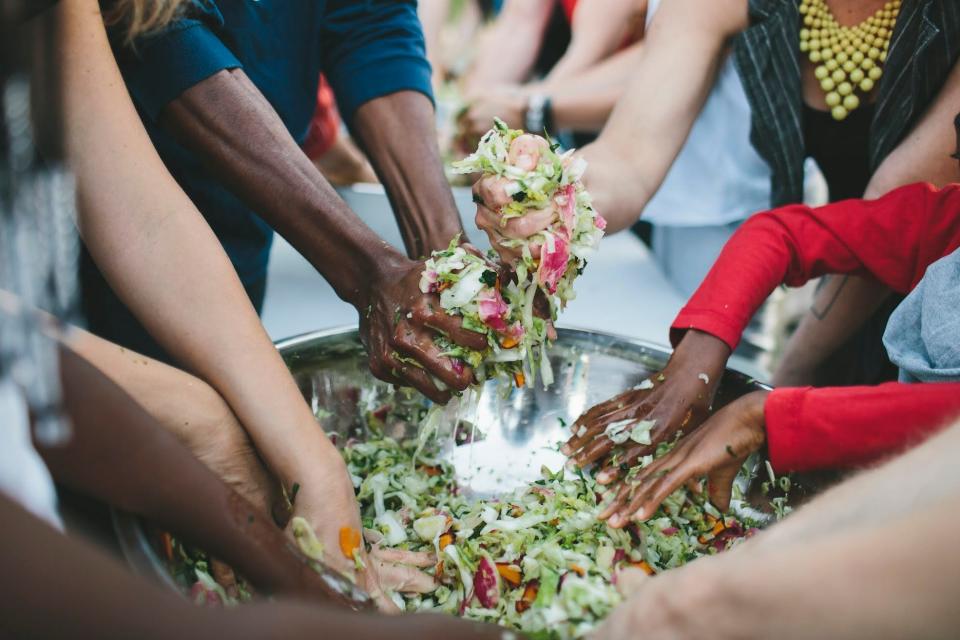How bacteria can make food safe (and delicious)

- Oops!Something went wrong.Please try again later.
A Mason jar sits on my kitchen counter. Stuffed with shredded cabbage, the contents look like any jar you might find on a supermarket shelf. But what's inside is alive. When I loosen the lid, the cabbage hisses and bubbles.
Fermentation is taking place inside the jar. In a few weeks, when I decide the taste is right, I'll move the jar to the refrigerator to stop the fermentation, and I'll have a jar of homemade sauerkraut.
The sauerkraut is my first foray into fermentation. But it won't be my last. Earlier this month, I attended a lecture and workshop hosted by Sandor Ellix Katz, America's leading evangelist for fermentation. Katz, who dressed for the lecture in a hoodie printed with pickles, has a knack for making one of the oldest preservation techniques feel hip.
"People everywhere ferment," Katz said.
When life gives you cabbage ...
Katz learned to ferment out of necessity. When he was younger, he moved from New York City to a commune in Tennessee. He planted his first garden, and the city kid soon discovered that a row of cabbage needs to be harvested all at once.
With way more cabbage than anyone wanted to eat, Katz turned to his trusty copy of "The Joy of Cooking" for a sauerkraut recipe. The process was simply. Shred the cabbage. Mash it up to release juices and rupture cell walls. Add some seasoning, sprinkle with salt and then wait.
He learned the first lesson of fermentation: It is one of the easiest ways to preserve foods.
As Katz noted, people have been preserving food with fermentation for 10,000 years, but we have only understood the bacterial process for 150 years.
Fermentation can also break down, or pre-digest, foods, so our body can absorb the nutrients, for example the protein in soybeans.
"There is always a practical benefit to fermentation," he said.
He also learned the second important thing about fermentation: It can make desirable, often assertive flavors.
"Not everyone will agree on what is desirable," he said.

So much of what we eat, including yogurt, cheese, miso, sourdough bread, kimchi and even chocolate, is fermented. Most condiments, from ketchup to Dijon mustard, rely on vinegar, which is fermented. And fermentation makes the alcohol in beer, wine and whiskey.
Katz was hooked and has spent his life teaching and writing about fermentation in award-winning books like "Wild Fermentation," "The Art of Fermentation" and "Fermentation Journeys: Recipes, Techniques, and Traditions from Around the World."
Do not fear bacteria
For most people, bacteria is literally a dirty word. We buy special soaps and cleaners that promise to kill all the bacteria on our hands and kitchen counters. Not all bacteria, however, is bad, Katz said. Our bodies are full of helpful bacteria. And fermentation could not exist without bacteria.
"Food does not get safer than fermented vegetables," Katz said.
Lactic acid bacteria is on every plant we eat. Create the right conditions, and the lactic acid will become dominant, wiping out any harmful bacteria, like E. coli, as it ferments the vegetable.
Fermented foods, Katz stresses, are safer than raw vegetables.
"It's so easy for people to project their anxiety about bacteria on fermentation," he said.

Sandor Katz's sSauerkraut
The sauerkraut method is also referred to as dry-salting, because typically no water is added and the juice under which the vegetables are submerged comes from the vegetables themselves. This is the simplest and most straightforward method, and results in the most concentrated vegetable flavor.
Time frame: three days to three months (and beyond)
Vessel: 1-quart (1-liter) wide-mouth jar, or a larger jar or crock
Ingredients
2 pounds of vegetables, which can be any varieties of cabbage alone or in combination, or at least half cabbage and the remainder any combination of radishes, turnips, carrots, beets, kohlrabi, Jerusalem artichokes, onions, shallots, leeks, garlic, greens, peppers or other vegetables
Approximately 1 tablespoon salt (start with a little less, add if needed after tasting)
Other seasonings as desired, such as caraway seeds, juniper berries, dill, chili peppers, ginger, turmeric, dried cranberries or whatever you can conjure in your imagination
Instructions
Prepare the vegetables. Remove the outer leaves of the cabbage and reserve. Scrub the root vegetables but do not peel. Chop or grate all vegetables into a bowl. The purpose of this is to expose surface area in order to pull water out of the vegetables, so that they can be submerged under their own juices. The finer the veggies are shredded, the easier it is to get juices out, but fineness or coarseness can vary, with excellent results.
Salt and season. Salt the vegetables lightly and add seasonings as you chop. Sauerkraut does not require heavy salting. Taste after the next step and add more salt or seasonings, if desired. It is always easier to add salt than to remove it. (If you must, cover the veggies with dechlorinated water, let this sit for 5 minutes, then pour off the excess water.)
Squeeze the salted vegetables with your hands for a few minutes (or pound with a blunt tool). This bruises the vegetables, breaking down cell walls and enabling them to release their juices. Squeeze until you can pick up a handful and when you squeeze, juice releases (as from a wet sponge).
Pack the salted and squeezed vegetables into your jar. Press the vegetables down with force, using your fingers or a blunt tool, so that air pockets are expelled and juice rises up and over the vegetables. Fill the jar not quite all the way to the top, leaving a little space for expansion. The vegetables have a tendency to float to the top of the brine, so it’s best to keep them pressed down, using one of the cabbage’s outer leaves, folded to fit inside the jar, or a carved chunk of a root vegetable, or a small glass or ceramic insert. Screw the top on the jar; lactic acid bacteria are anaerobic and do not need oxygen (though they can function in the presence of oxygen). However, be aware that fermentation produces carbon dioxide, so pressure will build up in the jar and needs to be released daily, especially the first few days when fermentation will be most vigorous.
Wait. Be sure to loosen the top to relieve pressure each day for the first few days. The rate of fermentation will be faster in a warm environment, slower in a cool one. Some people prefer their krauts lightly fermented for just a few days; others prefer a stronger, more acidic flavor that develops over weeks or months. Taste after just a few days, then a few days later, and at regular intervals to discover what you prefer. Along with the flavor, the texture changes over time, beginning crunchy and gradually softening. Move to the refrigerator if you wish to stop (or rather slow) the fermentation. In a cool environment, kraut can continue fermenting slowly for months. In the summer or in a heated room, its life cycle is more rapid; eventually it can become soft and mushy.
Surface growth. The most common problem that people encounter in fermenting vegetables is surface growth of yeasts and/or molds, facilitated by oxygen. Many books refer to this as “scum,” but I prefer to think of it as a bloom. It’s a surface phenomenon, a result of contact with the air. If you should encounter surface growth, remove as much of it as you can, along with any discolored or soft kraut from the top layer, and discard. The fermented vegetables beneath will generally look, smell and taste fine. The surface growth can break up as you remove it, making it impossible to remove all of it. Don’t worry.
Recipe courtesy of Sandor Katz. Visit www.wildfermentation.com for more information about Katz and fermentation.
Todd A. Price writes about food and culture in the South. He can be reached at taprice@gannett.com.
This article originally appeared on Nashville Tennessean: The secrets of fermentation from Sandor Katz

